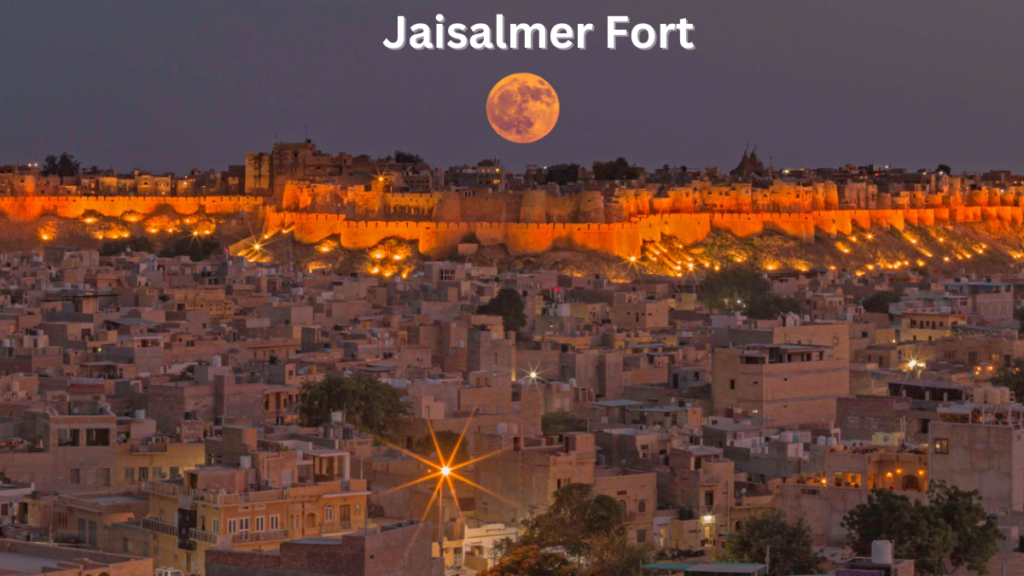Introduction
Nestled in the heart of the golden Thar Desert, Jaisalmer Fort stands tall and proud, shimmering like a beacon of history and heritage. Known as Sonar Quila or the Golden Fort, this UNESCO World Heritage Site is not just a majestic structure but a living, breathing testament to Rajasthan’s rich past. Unlike other forts, Jaisalmer Fort is home to more than 2,000 people, making it a unique blend of ancient architecture and vibrant modern life. If you’re a history buff, architecture enthusiast, or someone simply looking for a place that oozes charm and stories, Jaisalmer Fort is calling your name!
The fort’s towering presence, gleaming golden in the desert sunlight, offers an almost mystical feel. As you wander through its ancient walls, it feels like you’ve stepped back in time. In this blog post, we’re going to explore the fascinating history, architecture, legends, and vibrant life within this stunning fort. Get ready to dive into the stories that make Jaisalmer Fort more than just a beautiful landmark—it’s a living legend!

A Glimpse into History: The Birth of Jaisalmer Fort
The story of Jaisalmer Fort dates back to 1156 AD, when Maharawal Jaisal, the Rajput ruler, decided to establish the fort on Trikuta Hill. Strategically located along the ancient trade routes between India and Persia, the fort became an important military stronghold and a hub for merchants. It wasn’t just a fort; it was a place where royalty, soldiers, and traders mingled, creating a bustling hub of commerce and culture in the heart of the desert.
Jaisalmer Fort has witnessed centuries of history—from the battles and skirmishes fought for its protection to the rich cultural exchanges that took place through its trade connections. In its early days, the fort was a center of defense for the Kingdom of Marwar, and its strategic location in the desert made it a crucial spot for the Rajputs to ward off invaders. The fort’s survival through so many centuries is a testament to the resilient spirit of the people of Jaisalmer, who protected it with everything they had, turning it into the iconic symbol it is today.
Architectural Marvel: The Golden Beauty
As you approach Jaisalmer Fort, one thing becomes immediately clear—the fort is a masterpiece of architecture. The golden sandstone used in its construction is what gives it its iconic “golden” hue, which becomes particularly enchanting during sunset when the fort almost glows against the fiery desert sky. The intricate carvings and delicate details on the walls and arches are a sight to behold. The combination of Rajput and Islamic architectural styles gives the fort its distinct look, making it stand out from other forts in India.
The fort’s massive ramparts, narrow lanes, and four grand gates (known as pols) give it a fortress-like charm. Inside, you’ll find beautifully decorated palaces, temples, and courtyards that are a delightful maze to explore. The Raj Mahal (Royal Palace) is a prime example of regal architecture, with its rich carvings, frescoes, and mirrors that reflect the royal lifestyle of the bygone era. You can almost imagine the royal families and their entourages strolling through these halls, bringing the past to life in your imagination.
Inside the Fort: Temples, Palaces, and Living Spaces
But Jaisalmer Fort is not just a monumental structure; it’s also home to vibrant life. Unlike other forts that are simply ruins or tourist attractions, Jaisalmer Fort is a living, thriving community. Over 2,000 people still live within its walls, continuing their traditional livelihoods, such as crafting, weaving, and selling goods in the local market. It’s not just a history lesson; it’s an immersive experience.
Inside the fort, you’ll discover several Jain temples that are architectural gems in their own right. These temples, dating back to the 12th and 15th centuries, are exquisitely carved from yellow sandstone and are a tribute to Jainism’s rich heritage. They are peaceful sanctuaries amidst the hustle and bustle of the market lanes, offering a serene escape. As you explore, you’ll also come across hidden courtyards, beautifully painted walls, and charming little shops selling everything from vibrant textiles to ornate jewelry. Living history is all around you, making the fort feel less like a museum and more like a storybook.
The Stories of the Fort: Legends and Lore
Every corner of Jaisalmer Fort holds a story, and it’s these stories that make the fort so fascinating. From the legends of love and bravery to tales of battle and sacrifice, the fort is rich with folklore that’s been passed down through generations. One of the most famous stories is that of Rani Ka Mahal, the queen’s palace, which is said to be haunted by the spirit of a king’s beloved queen. Her tragic love story and her untimely death have inspired many local legends, and the palace continues to capture the imagination of visitors who come to hear its mysterious tales.
The fort is also steeped in military history, having withstood numerous invasions and attacks. The bravery of the Rajputs who defended the fort is legendary, and it’s said that during one siege, the defenders chose to fight to the death rather than surrender, a testament to their courage and dedication. These stories, filled with valor and sacrifice, echo in the air as you walk through the fort’s ancient halls and chambers, making it an unforgettable journey into the past.
Jaisalmer Fort as a UNESCO World Heritage Site
In 2013, Jaisalmer Fort was honored with the prestigious title of a UNESCO World Heritage Site, and it’s no wonder! The fort’s rich history, stunning architecture, and cultural significance make it a global treasure. It’s one of the largest living forts in the world and remains a symbol of Rajasthan’s heritage and pride. The UNESCO designation has also helped to preserve the fort’s unique charm, encouraging conservation efforts while still allowing visitors to experience its living culture.
The recognition also ensures that future generations can enjoy this magnificent fort as much as we do today. Efforts to preserve the fort have included cleaning its sandstone walls, restoring temples, and maintaining the delicate balance between tourism and local life. It’s a delicate dance, but the ongoing preservation of Jaisalmer Fort means it will continue to stand proudly for centuries to come, telling its stories to all who visit.
The Living Culture of Jaisalmer Fort
Jaisalmer Fort is more than just a historical site; it’s a thriving community that celebrates its vibrant culture. The fort’s narrow alleys are alive with people, many of whom have lived here for generations. The fort is home to several local artisans, selling everything from handwoven textiles to handcrafted jewelry. It’s a wonderful place to buy authentic souvenirs and support local artisans, all while soaking in the atmosphere of this historic site.
In addition to shopping, you’ll find plenty of traditional crafts being practiced within the fort’s walls. Bandhani textiles, block printing, and puppet-making are just a few of the arts that thrive here. Visitors are often invited to watch artisans at work, offering a fascinating look into the craftsmanship that has been passed down for centuries. The fort’s residents are known for their warmth and hospitality, making it a special place where you can truly feel the soul of Jaisalmer.
Visiting Jaisalmer Fort: What to See and Do
When you visit Jaisalmer Fort, there’s so much to see and do! Start your journey by exploring the Jain Temples, with their exquisite carvings and serene atmosphere. Don’t miss the Raj Mahal, where you can marvel at the grandeur of the royal chambers. The Rani Ka Mahal is another must-see, especially for those who enjoy a little mystery with their history. If you’re feeling adventurous, head to the fort ramparts for some stunning panoramic views of the desert landscape below.
Another must-do activity is shopping in the bustling market inside the fort. The market is full of life, with vendors selling everything from handmade rugs to leather goods and spices. It’s the perfect spot to pick up a memento of your visit or simply enjoy the vibrant atmosphere. And for those looking for a bit of peace and reflection, the Vyas Chhatri and Gadsisar Lake offer tranquil settings that are perfect for some quiet contemplation.
Jaisalmer Fort in Modern Times: A Living Heritage
Jaisalmer Fort has managed to maintain its authenticity even in the face of modern challenges. While the influx of tourism could have overshadowed the fort’s historic significance, it remains a thriving center of local life. The residents continue to live in their traditional homes, go about their daily routines, and pass on the crafts and culture that have made the fort so special. It’s not just a place to visit; it’s a place to experience and understand how history can live on in the modern world.
The challenge of preserving a living heritage while accommodating tourists is not easy, but the community’s dedication to keeping the fort’s traditions alive is evident. Local conservation efforts, coupled with UNESCO’s guidance, are ensuring that the fort’s future is just as bright as its past. This delicate balance between preservation and modernization is what makes Jaisalmer Fort so special.
Conclusion
In conclusion, Jaisalmer Fort is more than just a beautiful desert fortress—it’s a living, breathing piece of history. From its golden sandstone walls to the legends and stories that echo through its halls, this fort is a testament to Rajasthan’s royal past and vibrant present. Whether you’re exploring its temples, shopping
in its bustling markets, or listening to the stories of its residents, Jaisalmer Fort is an unforgettable experience.
So, if you’re ever in Rajasthan, make sure to take the time to visit this golden wonder. It’s not just a fort—it’s a journey through time, culture, and stories waiting to be discovered.






